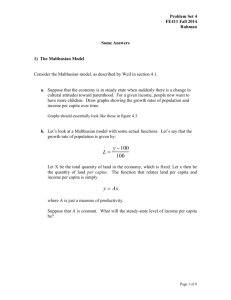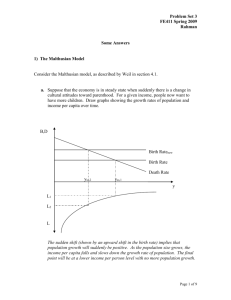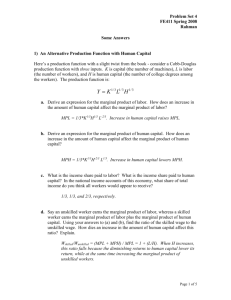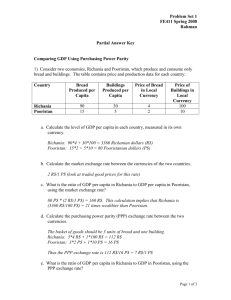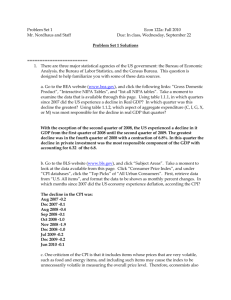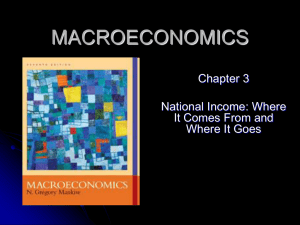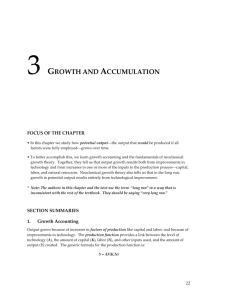Partial Answer Key
advertisement
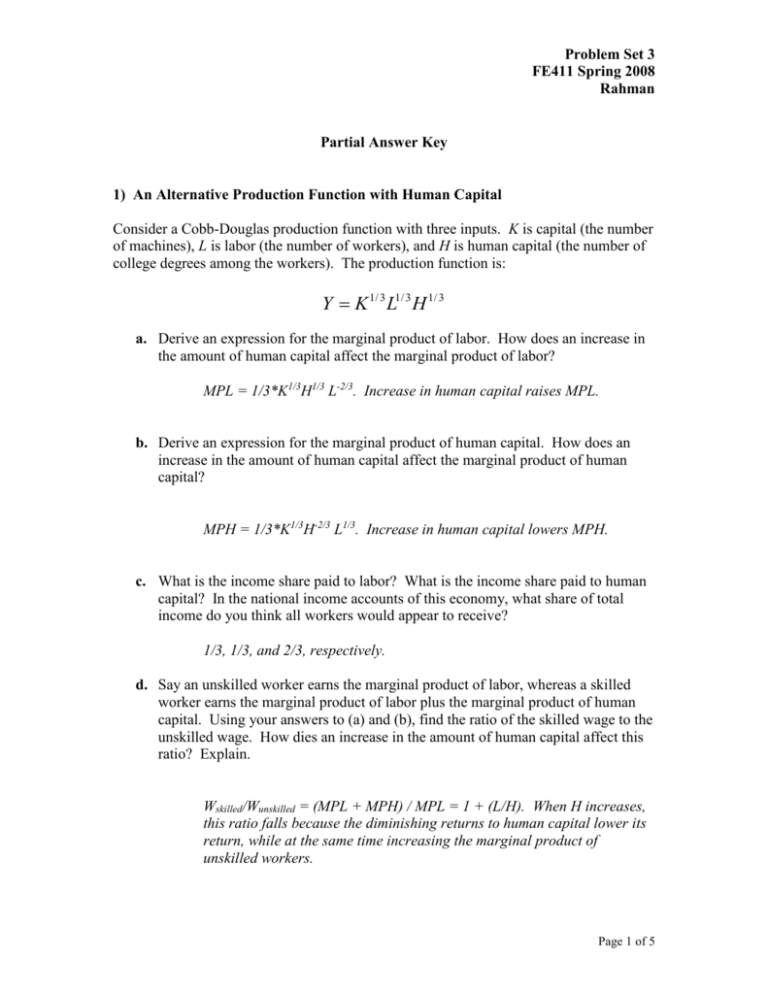
Problem Set 3 FE411 Spring 2008 Rahman Partial Answer Key 1) An Alternative Production Function with Human Capital Consider a Cobb-Douglas production function with three inputs. K is capital (the number of machines), L is labor (the number of workers), and H is human capital (the number of college degrees among the workers). The production function is: Y K 1/ 3 L1/ 3 H 1/ 3 a. Derive an expression for the marginal product of labor. How does an increase in the amount of human capital affect the marginal product of labor? MPL = 1/3*K1/3H1/3 L-2/3. Increase in human capital raises MPL. b. Derive an expression for the marginal product of human capital. How does an increase in the amount of human capital affect the marginal product of human capital? MPH = 1/3*K1/3H-2/3 L1/3. Increase in human capital lowers MPH. c. What is the income share paid to labor? What is the income share paid to human capital? In the national income accounts of this economy, what share of total income do you think all workers would appear to receive? 1/3, 1/3, and 2/3, respectively. d. Say an unskilled worker earns the marginal product of labor, whereas a skilled worker earns the marginal product of labor plus the marginal product of human capital. Using your answers to (a) and (b), find the ratio of the skilled wage to the unskilled wage. How dies an increase in the amount of human capital affect this ratio? Explain. Wskilled/Wunskilled = (MPL + MPH) / MPL = 1 + (L/H). When H increases, this ratio falls because the diminishing returns to human capital lower its return, while at the same time increasing the marginal product of unskilled workers. Page 1 of 5 Problem Set 3 FE411 Spring 2008 Rahman e. Some people advocate government funding of college scholarships as a way of creating a more egalitarian society. Others argue that scholarships help only those who are able to go to college. Do your answers to the preceding questions shed light on this debate? If more college scholarships increase H, then it does lead to a more egalitarian society. The policy lowers the returns to education, decreasing the gap between the wages of more and less educated workers. More importantly, the policy even raises the absolute wage of unskilled workers because their marginal product rises when the number of skilled workers rises. 2) Physical and Human Capital as Perfect Complements Consider two countries, Sri Lanka and Japan. Both countries have a production function per person where physical capital per person (k) and human capital per person (h) are the only two inputs in production. Specifically, the production function per person is: y min[ k , h] Suppose Sri Lanka has a low rate of physical capital investment and a very low k. Japan on the other hand as a high rate of physical capital investment and a moderate amount of k. Both countries are the same in all other respects, INCLUDING VERY LARGE LEVELS OF HUMAN CAPITAL. a. Which country do you predict will grow faster in the short term? Why? Japan. Because both countries have large h’s, we would expect physical capital per person to be the relatively scare factor, so only growth in k will allow growth in y. Thus in the short run, Japan should grow faster because its investment rate in physical capital is higher. b. Which country do you predict will grow faster in the long term? Why? Sri Lanka. Once Japan has large levels of both k and h, its growth stops once k = h, further increases in k does nothing to increase y. Since Sri Lanka starts with such an imbalanced situation, where k <<< h, it can grow for a much longer period of time by increasing k though physical capital investment. Page 2 of 5 Problem Set 3 FE411 Spring 2008 Rahman 3) The Malthusian Model Consider the Malthusian model, as described by Weil in section 4.1. a. Suppose that the economy is in steady state when suddenly there is a change in cultural attitudes toward parenthood. For a given income, people now want to have more children. Draw graphs showing the growth rates of population and income per capita over time. At point a, the population size is stable with no growth. With a sudden change in cultural attitudes, the curve relating the population growth rate and income per capita shifts upward. The sudden shift implies that population growth will suddenly be positive (point b). As the population size grows and as income per capita falls, the growth rate of population will fall. At point c, the country will be in a Malthusian steady-state population level with no growth. Income per capita is now at a permanently lower level than before. L c Income per capita, y Page 3 of 5 Problem Set 3 FE411 Spring 2008 Rahman Population growth 0 b c a yss Income per capita, y b. Let’s look at a Malthusian model with some actual functions. Let’s say that the growth rate of population is given by: L y 100 L and suppose that output is produced using labor and land, according to the equation: Y L1/ 2 X 1/ 2 where X is the quantity of land. Assume that X = 1,000,000. Derive the relationship between population, L, and income per capita, y (remember that y ≡ Y/L). Use the equations you have derived to compute the STEADY-STATE values of L and y. First, we divide both sides of the production function by L and rearrange to get: 1/ 2 L1 / 2 X 1 / 2 X y Y /L , L L Therefore, L X y2 Page 4 of 5 Problem Set 3 FE411 Spring 2008 Rahman In the steady state, the growth rate of population, L , is zero. Using this value and L rearranging the first equation, we solve for the steady-state value of income per capita: L 0 y 100, L y ss 100 Substituting in this value into the production function, we back out the value of Lss as follows: Lss X y ss 2 1,000,000 100 (100) 2 The steady-state population is 100. Page 5 of 5
